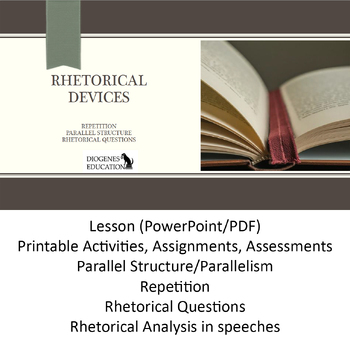Rhetorical Devices: Parallel Structure Repetition Rhetorical Question L.9-10.1a
- Zip
What educators are saying
Also included in
- The High School ELA bundle includes:* Powerpoint lessons aligned to teaching Common Core Standards* Classroom activities and discussions* Assignments, Assessments, and Rubrics/Answers keys when applicable* Graphic organizers* Review Games* Teacher Lesson Plans* "Memes of the Day" and pop culturePrice $69.99Original Price $85.91Save $15.92
- Poetry, fiction, graphic novels, expository writing, research, activities, worksheets, assessments, posters, lessons--all printable and all time-saving. For any grade 9-10, native speaker or ESL, it's already differentiated with a tiered assessments: Pick and choose the difficulty as you go!It's allPrice $241.84Original Price $268.71Save $26.87
- AP Language & Composition full course! Everything you need to write an essay earning a perfect score on the AP Test. Contains units on: ethos, pathos, logos; logical fallacies, figurative language, irony, and subtext; source analysis; and more! Includes 4 Bonus lessons in this bundle focusing onPrice $49.99Original Price $108.89Save $58.90
Description
A unit on Rhetorical Devices: parallel structure (parallelism), repetition, and rhetorical questions. Using Foundational American texts and relatable pop culture examples, this unit focuses on analysing how rhetoric improves writing.
Contains pop culture examples (such as lyric excerpts by Beyonce, the Talking Heads, and Star Wars quotes), important text from American History (including Martin Luther King Jr's "I Have a Dream" speech and John F. Kennedy's inaugural Address, and Lincoln's "Gettysburg Address") and Shakespearean examples (Marc Antony's speech from Julius Caesar). Includes:
* Guided lesson in Powerpoint and PDF formats
* Handouts for guided notetaking during lessons
* Guided discussion Prompts
*Classroom Activities
* Assignments
* Video examples of speeches for differentiated learning to assist audio/visual learners
Key Common Core Standards met:
L.9-10.1a
L.9-10.1b
RI.9-10.6
RI.9-10.9
W.11-12.2c
CCRA.R.4
CCRA.SL.3
L.11-12.3a
RI.11-12.6
RI.11-12.8
RI.11-12.9
W.11-12.9b
==============
Check out our other lessons to improve writing
- Can you apply rhetorical devices in your writing?: Essay Writing
- For a unit analyzing technology's affect on writing: Ethical A.I. vs ChatGPT
- For a unit on Media Literacy, Bias, and Propaganda: Media Literacy
- Rhetorical Devices as Pathos: Rhetorical Triangle
- For a lesson on Argumentative Writing and Debate: Logical Fallacies
- For our popular Diction and Euphemisms unit: Connotation vs Denotation
- For a lesson on citing evidence in an essay: MLA Citation
- For a unit on punctuation (semi-colons and more): Punctuation and SVO
- View our full store at: Diogenes Education TPT
- More information or contact us here: Diogenes Education
=============
If you like this product, please leave a review: Not only does it help us create more great products like this, but for every review you leave you earn TpT credits toward discounts on future orders on the store!








